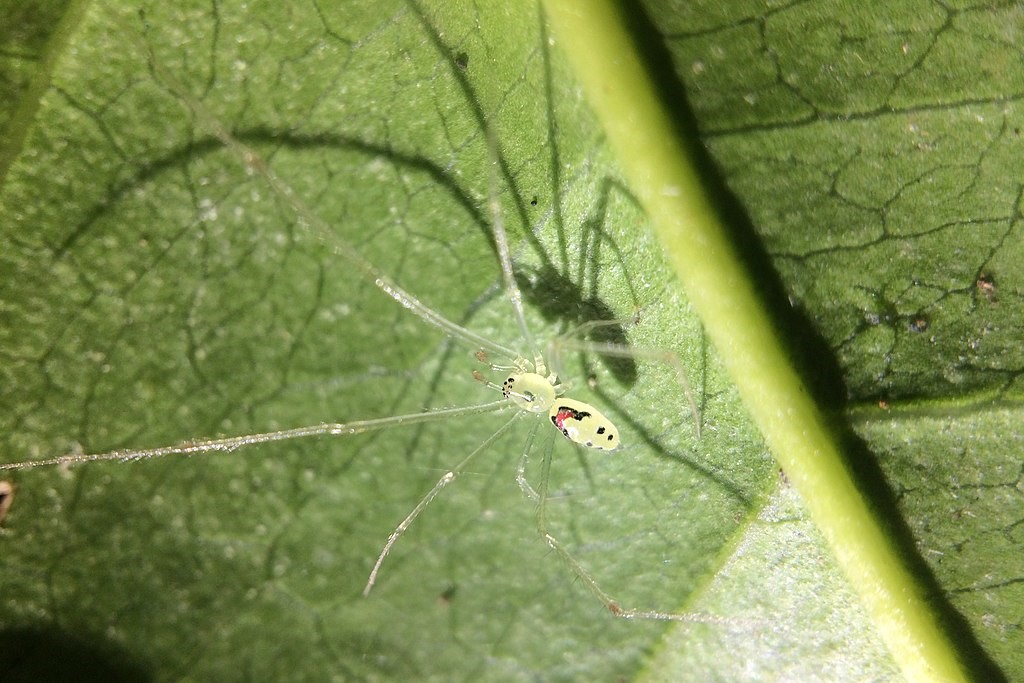Happy Face Spiders, scientifically known as Theridion grallator, are a fascinating species of arachnids native to the Hawaiian islands. They are renowned for their distinctive abdominal markings resembling a smiling face, which has earned them their common name. These spiders belong to the family Theridiidae, which includes other well-known species like the black widow.
First described in the late 1800s, Happy Face Spiders are relatively small in size, with adults typically measuring around 5 to 7 millimeters in body length. Their abdomens, where the iconic “smiley face” pattern is located, are usually a combination of yellow, white, and black markings. The purpose of this unique pattern is not entirely clear, but it’s thought to play a role in deterring predators or attracting mates.
These spiders are primarily found in the lush rainforests of Hawaii, particularly on the islands of Maui, Oahu, and Hawaii. They prefer habitats with dense vegetation where they can construct their intricate orb webs. Unlike some other spider species, Happy Face Spiders are not aggressive towards humans and are generally harmless. They feed primarily on small insects and prey that become ensnared in their webs.
One remarkable aspect of Happy Face Spiders is their ability to exhibit a wide range of abdominal markings beyond the classic “smiley face.” Some individuals may have variations that resemble frowns, crosses, or even abstract patterns. This diversity in markings has intrigued scientists and has led to studies exploring the genetic and environmental factors that influence this variability.
Despite their small size and inconspicuous nature, Happy Face Spiders play a vital role in their ecosystem by helping to control insect populations. However, like many other species, they face threats from habitat loss and human activity. Conservation efforts aimed at preserving the delicate balance of Hawaii’s ecosystems are crucial for ensuring the continued survival of these charming and unique arachnids.

Happy Face Spider
What about Happy Face Spiders interesting facts? Here are 10 interesting facts about Happy Face Spiders.
- Scientific Name: Happy Face Spiders are scientifically known as Theridion grallator.
- Distinctive Markings: They have abdominal markings resembling a smiling face, hence their common name.
- Size: Adult Happy Face Spiders typically measure around 5 to 7 millimeters in body length.
- Family: They belong to the Theridiidae family, which also includes black widow spiders.
- Habitat: Happy Face Spiders are native to the Hawaiian islands.
- Preferred Environment: They are commonly found in lush rainforests with dense vegetation.
- Nocturnal Behavior: These spiders are most active during the night.
- Diet: Happy Face Spiders primarily feed on small insects caught in their webs.
- Venom: While they possess venom to immobilize prey, their venom is not harmful to humans.
- Web Construction: They construct intricate orb webs to catch prey.
- Mating Rituals: Mating rituals can involve elaborate courtship displays.
- Reproduction: Female Happy Face Spiders lay eggs in silk sacs, protecting them until they hatch.
- Development: Spiderlings undergo several molts before reaching adulthood.
- Variability in Abdominal Markings: Some individuals may have variations in their abdominal patterns, such as frowns or crosses.
- Coloration: Their abdominal markings are typically a combination of yellow, white, and black.
- Solitary Nature: Happy Face Spiders are solitary creatures, usually coming together only for mating.
- Predators: They face predation from birds, lizards, and other spiders.
- Conservation Status: Habitat loss threatens their populations in some areas.
- Endemic Species: Happy Face Spiders are endemic to Hawaii, found nowhere else in the world.
- Cultural Significance: They are featured in Hawaiian folklore and artwork.
- Educational Interest: They are often used in educational programs to teach about biodiversity.
- Research: Scientists study Happy Face Spiders to understand their behavior and ecology.
- First Description: They were first scientifically described in the late 1800s.
- Adaptive Radiation: They are an example of adaptive radiation in island ecosystems.
- Genetic Studies: Researchers explore the genetic factors influencing their unique markings.
- Social Behavior: Happy Face Spiders exhibit limited social behaviors, primarily related to mating.
- Symbolism: In Hawaiian culture, they symbolize the interconnectedness of nature.
- Conservation Efforts: There are ongoing efforts to protect their habitats and populations.
- Role in Ecosystem: Happy Face Spiders play a crucial role in controlling insect populations.
- Continued Fascination: Despite their small size, Happy Face Spiders continue to captivate the interest of scientists and nature enthusiasts worldwide.
Happy Face Spiders stand as a testament to the remarkable diversity and beauty of nature, particularly within the unique ecosystems of the Hawaiian islands. With their charming smiley face markings, intricate web-building skills, and important role in controlling insect populations, these spiders have earned both scientific fascination and cultural significance. While they face challenges such as habitat loss and predation, efforts to conserve their habitats and raise awareness about their importance continue. As symbols of Hawaii’s rich biodiversity and interconnectedness with the natural world, Happy Face Spiders serve as reminders of the delicate balance that sustains life on our planet.





